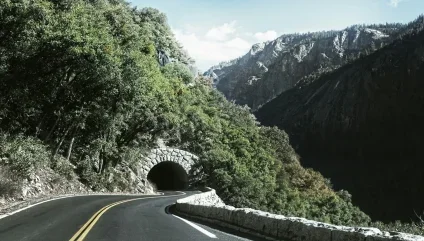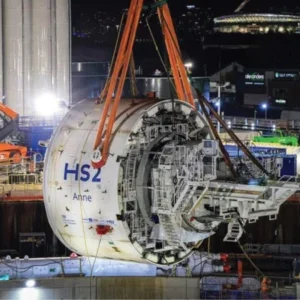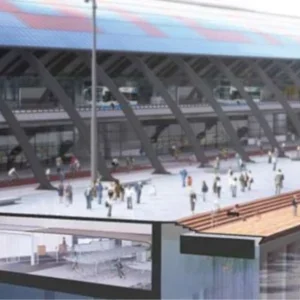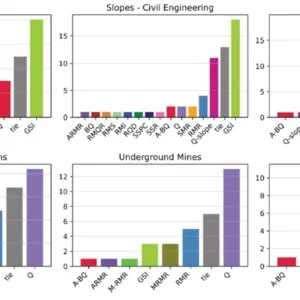
Himalayas, the gigantic mountain range stretching for almost 2400km in Asia and having some of the highest peaks in the world, is very rich in diversified geology, hosting precious minerals, heavenly glaciers, source of many lives sustaining rivers, incredible rock formations, colourful fossil deposits and much more.
The beautiful rock formations are live examples of some epic cases which are confined mostly only in books. One can observe all type of rockmass whether being igneous, sedimentary or metamorphous, their varying nature, different types of folding and faulting, vast shear zones while working in the area. Besides being a geological masterpiece, it is also a haven for tunnelling professionals working in the area.
Working in a single bit of the area is a lesson for lifetime.
PROJECT NEEDS AND OPPORTUNITIES
I am Ahmed Shaz, Assistant Manager (Tunnels) from RITES Limited and one of the rare fortunate tunnelling professionals who got the opportunity to work in this marvellous terrain, associated with some of the most prestigious tunnel projects of India.
We are working for seven tunnel DPR projects in Leh Ladakh, India, mainly to provide all weather connectivity to the secluded areas which get disconnected in winters because of heavy snow accumulation near the high altitude passes, mostly above 5000m altitude, above mean sea level (amsl).
Besides heavy snow accumulation, icing on road, risk of potential avalanches, debris flow are other major geological hazards which lead to frequent closing of roads, extensive snow clearances and subsequent road maintenance. The existing roads closure can be as much as six to seven months in winters, leading to an acute shortage of logistics at the high-altitude settlements of Ladakh. These issues are best mitigated by providing an alternate route through tunnels bypassing the critical stretch of these passes at much lower altitude.
The major factors according to which the alignment is finalised depends on the length of tunnel, which governs the cost and time of construction, altitude of the portals with respect to the snow line. It also decides the functional utility of the tunnel, reduction in road length leading to decrease in travelling time, location of the portals with respect to geology, type of ventilation system, maintainability of approach road to the tunnel portals, its contribution in the all-weather characteristics, and presence of potential risks on approaches among other factors.
The location of alignment with respect to geological features also play an important role in refining the alignment.
PRE-CONSTRUCTION WORK AND CHALLENGES
Pre-construction activities require a detailed survey to get all possible topographic and geological information along the finalised alignment. These surveys include geological mapping, geophysical surveys, extensive geotechnical drilling, topographic surveys, traffic surveys, highway inventory survey for approach roads, Environmental impact assessment surveys, including forest clearance and wildlife clearance, social impact assessment surveys, land acquisition surveys, etc.
Working in these high-altitude areas requires a proactive attitude and a positive mindset, as the challenges involved in getting the work done is tremendous. Health is also a major criterion to be able to work in this area.
First of all, the working season is very limited, hardly four to five months, which is further interrupted with frequent snowfalls, resulting in even lesser effective working time. The site remains in permafrost condition beyond this working season, with temperatures dipping below -20 °C to -30 °C during nights, practically making the place not feasible to work. Hence, planning of all field works are done well in advance so as to utilise the working season as much as possible.
Oxygen level in the area is very less, nearly 50% to 60%, which makes all the physical activities even more difficult. Oxygen cylinders are readily available at all sites and in vehicles to help in case of any urgent requirement.
Air pressure is also less. Our staff can frequently experience nausea, vomiting and headaches when they arrive from lower altitude areas. Proper acclimatisation is mandatory for everyone when they reach Leh (located at 3500m altitude), before proceeding to any of the tunnel sites.
Climatic conditions are very rough and harsh, the high velocity dry air in the evening especially near the passes makes it very difficult to even stand on site in the evening. The temperatures are mostly sub-freezing at night even in working season. The accumulated snow makes the sites difficult to access in early working season. Also, the presence of ice on the existing roads always poses a risk to the vehicles of skidding.
Prevailing Covid conditions (2020-2022) were also a major issue. In spite of taking the utmost precautions, at one instance half of the team got infected and remaining half had lost their motivation. Lack of oxygen in the area makes the unaffected ones also feels they are infected psychologically. But we had managed to cross that phase too, without the work getting affected. New team members joined the site, everyone infected was quarantined and given best medical support and fortunately everyone recovered.
Adding to the difficulty, most sites are in the extremely remote locations where there is hardly any settlement in the adjoining areas, meagre road connectivity to many project sites which requires 4×4 vehicles, no network connectivity, no electricity, no shops or restaurants in the vicinity.
FIELD SUPPORT AND DRILLING
We have site offices set up at various locations in Ladakh having inbuilt guest house facilities. Some close to main town of Leh, some at villages close to site (having network connectivity) and some site camps (in the form prefabricated shelters) exactly at site. All these site offices form a network which plays an important and synchronised role in the supply of required logistics, fuels, supply of required machine parts in case of breakdown, phases of acclimatisation for staff coming from lower altitude and liaison with the local and state administration for required support.
Due to the lack of connectivity, planning plays an important role in getting good progress in all parallel field activities running on each site. All small and big tasks for each day are pre-planned to an inch detail. Daily requirements of each site are planned well in advance, so that the work is not hampered in any case. All probable obstructions and delays are anticipated well in advance to tackle it in minimum time including breakdown of machines. We always have a backup plan ready if in case former doesn’t goes well. Regular review of project updates plays an important role in mitigation of site issues leading to unhampered progress. Satellite phone serves a great purpose in this whole operation, especially for daily project updates and help in case of any unfortunate event but due to the limited number of sets and frequent bad weather conditions, its usage is very limited.
Drilling of boreholes is a next level challenge for our team.
Geological mapping is carried out well in advance to finalise the borehole locations. In this limited time, making of kilometres long trace cuts leading to each drilling location is quite time consuming.
This is followed by mobilisation of drilling machines, drilling at multiple boreholes with each borehole going to a depth of approximately 20m below the formation level of the tunnel and then the safe demobilisation of the machines from the area before the passes are closed again for the next six to seven months. The number of machines required to do the drilling are planned as per the total depth of drilling and required number of boreholes. Drilling is further supplemented with required in-situ testing and laboratory testing.
Owing to the low air pressure, the efficiency of machines is much reduced. With increased altitudes the air pressure decreases and therefore air density decreases. In the first 1000m rise in altitude there is no reduction. After that, for every 1000m increase in elevation there is approx 10% reduction in efficiency of the machines. So, accordingly, all machines work at around 60% efficiency.
Also, there is lot of wear and tear in machines, and the basic philosophy of getting good work efficiency in these areas is having machines as new as possible. One breakdown in any machine can cause delay of many days as all big markets are too far from the site locations. We also used to keep an extra set of main spare parts subjected to wear and tear, water pumps and associated accessories at very machine to avoid these delays.
Supply of water to the drilling machines for their continuous functioning is also a challenging issue, as most of the boreholes do not have a natural water source in its vicinity. Several water tankers feed all boreholes, making multiple round trips to cater the need of drilling.
In September each year, as Winter begins to approach, issues related to low temperatures start to persist. Freezing of water channels, freezing of water in pits and pipes cause big hurdles in drilling works. Even the length of the trips for the water tankers gets subsequently increased to fill with water at much lower altitude. Sometimes heating arrangements were done at drilling site to melt the frozen water to maintain progress. By October, even the diesel starts to freeze inside the machines. We use some capsules to prevent freezing of diesel.
At one of our project sites, drilling water got frozen inside the borehole, to a depth as deep as 150m. This is quite contradictory to the normal scenario where freezing is limited to the top few meters from the ground due to lower temperatures, and it was suspected there was the presence of buried glacier deposits nearby, causing the whole underground formation to fall below sub-zero temperature. This caused a lot of issues, as every day the team started drilling in ice inside the borehole, and which consumed a lot of time to again reach the rock level at already drilled depth. We had used hot water, bentonite, salt, chemicals, urea but nothing worked much and cutting of ice had to persist on a daily basis. However, with the responsibility of getting the work done at the end of the season, our team worked day and night at the site in two shifts in most extreme conditions to meet the deadline, giving no time to water to get freeze inside the borehole.
Proper first aid, high end tents, heating arrangements supplemented with woods or kerosene, high end winter clothing were provided to the workers working at all project sites. Sometimes even mountain vehicles are arranged to take our team to the site location, when snow accumulation is high after heavy snowfall.
WONDERFUL LANDSCAPE
In spite of these hardships, looking to the beautiful landscape, the turquoise blue water, pure weather, colourful mountains give a treat to the eye and relaxes the tiring soul. Looking at hundreds of nomads rearing their pashmina goats in the extreme temperatures with meagre facilities makes you forget your hardships.
Although the terrain is marked with scarce vegetation, it’s very rich in fauna. You can encounter some of the rare and endangered species while working nearby site area. Presence of ibex, yak, wild horses, marmot is very common.
Close to winters, when water channels on high altitude are almost frozen, snow leopards and wolf are also encountered, although it’s a bit scary and no one wants it personally.
FIELD SURVEYS
Geophysical surveying is carried out to get a continuous geological information along the required stretch and to confirm the extent, depth and occurrences of suspected fault/anomalous/saturated zones in the area, especially those not accessible for drilling in the stipulated timeline. The information complements the geological mapping.
Also it’s a challenge, as the team had to trek along the alignment, crossing peaks having elevations more than 5000m amsl, with all the necessary instruments. Sometimes the help of mules and horses was needed. But trekking at altitude requires good health conditions.
In some of our projects, airborne electromagnetic survey (commonly known as AEM survey) was also carried out. It’s basically a geophysical survey, where an antenna is mounted over a helicopter which further takes it along the alignment, maintaining the distance between ground and antenna around 50m, to get a penetration depth of 600m to 700m below the ground surface.
We had hired Chinook helicopters for the purpose. Irrespective of the challenges associated with high altitudes taking multiple flights over a duration of week for each tunnel. The turbulence of air is very high near the peaks, requiring a wide turning radius in steep valleys. The peaks are nearly at the maximum flying altitude of Chinooks. But, with dedicated and consistent efforts, we managed to get the surveys done with good results.
On the completion of all required field activities, next challenge is to demobilise all machines and equipment safely from the area, as generally some of the other work takes last minute to get completed. Once stuck, it can lead to the idling of the machine for more than six months and a huge cost associated with it.
MOVING TO PLANNING AND DESIGN
After assessing all the data, the ground is characterised into several ground types along the alignment and accordingly different ground behaviours are assessed. These ground behaviours are further used in the design of excavation and support class along the alignment.
Primary Lining can be the combination of shotcrete with rockbolts, wire mesh, lattice girders, steel fibres, etc., as per the geology encountered. Secondary lining could be PCC lining with micro-fibres, concrete lining with micro-fibres and steel fibres, or concrete lining with conventional reinforcement bars and steel fibres based upon the design.
Considering the traffic flow in the area, length of the tunnel and requirement of ventilation, nearly all tunnels are planned as twin tubes allowing uni-directional traffic, connected with each other using cross passages at every 500m intervals. Also, considering the varying geology of the area, all tunnels are proposed to be constructed through NATM methodology.
Apart from the pre-construction activities, some technical challenges are anticipated during construction as well, that are taken care in our studies.
Concrete
One of the main challenges is concreting in low temperatures. IS 7861 Part II provides guidelines for concreting in less than 5°C. Challenges can be mitigated through use of rapid hardening cement, accelerators and maintaining cement content greater than 300kg/m3. Heating of water and aggregate needs to be done, but to not to more than 100°C at any instant, and with maximum temperature of water of 66°C. Temperatures and humidity records need to be assessed regularly. Air entrainment is necessary for alternate freezing and thawing conditions.
Transportation of concrete in low temperatures is the next anticipated challenge. The methodology to tackle this issue includes covering the concrete with insulation. Concrete need to have 10°C when it reached site for pouring and concrete temperature while placing shall not fall below 5°C. Concrete mixture truck shall not be stopped in open/cold temperatures. Also, temperatures and humidity records need to be checked at regular intervals.
Placing of concrete in low temperatures is also a challenge which can be mitigated by placing concrete as quickly as possible and insulation to be provided as soon as possible. The formwork to be kept longer in position, concrete to be covered with insulation and temperature of concrete to be maintained greater than 5°C while placing. Concrete temperature shall be maintained for at least seven days after pouring and steam heating to be carried out if required. Concrete shall not be poured against frozen sub-grade or against formwork covered with snow/ice. Temperatures and humidity records to be checked regularly. Various trials for design mix, demoulding, mixing and transportation need to be done.
There are challenges associated with shotcreting, related to its setting time, bonding with surface and rebound. The solutions include provision of early setting strength, option for dry shotcreting, storage of water, aggregate and cement inside tunnel, various trials for design mix, demoulding, mixing and transportation.
Water and waste
Managing water during construction can be a difficult task and can be done through insulated pipes to carry water outside tunnel for disposal, installing heating systems to provide water for personal or construction use, vacuum suction facilities to remove any water/ waste from pipes, and regular monitoring and maintenance of drains.
Managing wastes is also an important aspect during construction. Dumping of waste on snow cover may lead to uncontrolled flow in summers when the snow melts. The dumping area shall be covered and protected from snow to maintain proper dumping as planned.
Air – ventilation, and altitude
Ventilation during construction using cold air may lead to freezing inside tunnel during construction and may affect construction quality. Arrangements shall be made to maintain required working temperatures inside the tunnel. Closing of open face of tunnel with an air barrier can be done. Using warm air to ventilate tunnel in extreme weather condition is also a possible option.
As already mentioned, machine efficiency is decreased with increasing altitude, and the same was observed with the drilling machines used during pre-construction studies where reduction in machine efficiency was observed. The risks and its effects must be assessed by the contractor and considered while quoting the price.
Supplies and support during construction
Maintaining supplies throughout the year is also one of the biggest anticipated challenges as the roads in winters for nearly six months are difficult to maintain due to high snow accumulation and is generally closed. This will have direct impact on the construction time. Planning of material and supplies become very important.
All construction material such as cement, steel, aggregate, water, explosives, diesel, other components of required support systems, etc., has to be stored at site in sufficient quantities so that the progress is not hampered during winter season.
Other anticipated challenges down the line during construction include complying strict schedules by working throughout the year, maintaining accessibility to the project area especially in the winter season, provision of health facilities at site, maintaining oxygen chambers, heating supplies and arrangements, building a helipad for emergency escape, communication, electricity supply to the project area, and facilitating uninterrupted logistic supply during construction.
Our team had already been a part of construction of similar project at similar altitude. With all the experience gathered, we are confident enough to construct and deliver all the prestigious projects in the stipulated timeline.
QUESTIONS & ANSWERS
Following their presentation, during the webinar the speakers took a few questions which are summarised below.
Q: How beneficial was the AEM survey and how are the models produced from the data?
A: When AEM survey is done in high altitude regions, the AEM instrument is carried on large capacity helicopters. Elevation of the helicopter for these projects in Himalayas is about 6000m amsl during highest flights.
When the helicopters flying at such heights, it has many constraints to maintain stability of the instrument to gather the data, maintain speeds (minimum 80 km/hr) to negotiate for the disturbances from high-speed winds and move with sharp radius (1km to 2 km) while going through the peaks. This a major factor to get a deep penetration of electromagnetic radiation to up to 600m to 700m depths below the ground surface.
The data acquired by the AEM survey was quite good and relevant. The data were processed by the expert agencies and compared with data acquired from drilling boreholes, electrical resistivity surveys and seismic surveys for assessing geological conditions. The advantage of AEM survey was to acquire geological information in short time with data which was about 700m deep from the ground surface. Conducting boreholes was not possible for these projects in Himalayas and this is where this technology came in handy.
Q: How, in these projects in Himalayas, was the impact of vast permafrost regions factor into the plans, and what methodologies were suggested to carry out the construction?
A: This being a permafrost region, there will be a short window for carrying out construction which is a huge project risk as far as project programme is concerned. In projects done in past, the majority of work is done in the summers, with focus on high productivity and then taking break in winters.
But since these projects are on very swift timeline and are proposed to be very fast-paced, so it was important to find out the various ways to work in all weather conditions.
Further, we need to make sure that we plan things in such a way that tunnel approaches and portals are done preferably in summers and then carry on with tunnel construction in the winter periods.
The biggest challenge to continue working during winter is to manage the logistics and the supply of materials to the project site. This is going to be a difficult task there will be a lot more lessons to learn when the construction goes on. This is perhaps a unique experience for India as these are probably the highest tunnel portals in the world. To make these projects a success proper planning, programming, risk management and collaborative working is the key.






